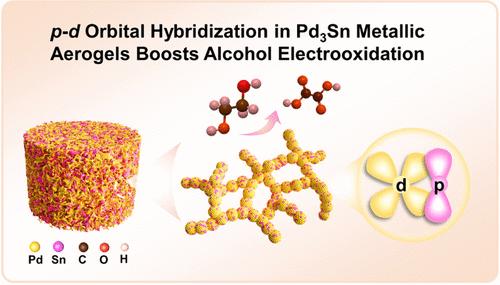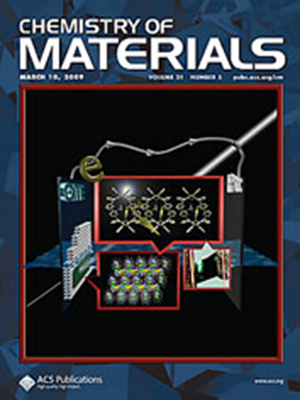p–d Orbital Hybridization in Pd3Sn Metallic Aerogels Boosts Alcohol Electrooxidation
IF 7.2
2区 材料科学
Q2 CHEMISTRY, PHYSICAL
引用次数: 0
Abstract
Orbital engineering of nanomaterials has been proven to be a compelling strategy, which stimulates the synthesis of palladium (Pd)-based nanomaterials with p–d orbital hybridization and the exploration of their electrocatalytic properties. Herein, Pd3Sn metallic aerogels (Pd3Sn MAs) with p–d orbital hybridization were reasonably constructed as efficient electrocatalysts for alcohol electrooxidation. In particular, the mass activity and specific activity of Pd3Sn MAs for the ethylene glycol oxidation reaction are 1.69 A mgPd–1 and 3.56 mA cmPd–2, respectively, superior to Pd MAs and commercial Pd/C. Meanwhile, benefiting from the excellent antipoisoning properties, Pd3Sn MAs still maintain satisfactory activity after long-term durability tests. Moreover, the same trend can be observed in reactions such as the methanol oxidation reaction, the ethanol oxidation reaction, and the glycerol oxidation reaction. Furthermore, density functional theory calculations reveal that the p–d orbital hybridization of Pd3Sn MAs precisely regulates the electronic structure and d-band center of Pd and also decreases the reaction energy barrier in the rate-determining step, thus reactivating the surface of Pd3Sn MAs. This study provides a broad prospect for the design of efficient fuel cell electrocatalysts through orbital engineering.

Pd3Sn 金属气凝胶中的 p-d 轨道杂化可增强酒精电氧化作用
纳米材料的轨道工程已被证明是一种引人注目的策略,它促进了具有 p-d 轨道杂化的钯 (Pd) 基纳米材料的合成及其电催化性能的探索。本文合理地构建了具有 p-d 轨道杂化的 Pd3Sn 金属气凝胶(Pd3Sn MAs),作为酒精电氧化的高效电催化剂。其中,Pd3Sn MAs 在乙二醇氧化反应中的质量活性和比活性分别为 1.69 A mgPd-1 和 3.56 mA cmPd-2,优于 Pd MAs 和商用 Pd/C。同时,得益于优异的抗中毒特性,Pd3Sn MAs 在经过长期耐久性测试后仍能保持令人满意的活性。此外,在甲醇氧化反应、乙醇氧化反应和甘油氧化反应等反应中也可以观察到相同的趋势。此外,密度泛函理论计算表明,Pd3Sn MAs 的 p-d 轨道杂化精确地调节了 Pd 的电子结构和 d 带中心,也降低了决定速率步骤中的反应能垒,从而重新激活了 Pd3Sn MAs 的表面。这项研究为通过轨道工程设计高效燃料电池电催化剂提供了广阔的前景。
本文章由计算机程序翻译,如有差异,请以英文原文为准。
求助全文
约1分钟内获得全文
求助全文
来源期刊

Chemistry of Materials
工程技术-材料科学:综合
CiteScore
14.10
自引率
5.80%
发文量
929
审稿时长
1.5 months
期刊介绍:
The journal Chemistry of Materials focuses on publishing original research at the intersection of materials science and chemistry. The studies published in the journal involve chemistry as a prominent component and explore topics such as the design, synthesis, characterization, processing, understanding, and application of functional or potentially functional materials. The journal covers various areas of interest, including inorganic and organic solid-state chemistry, nanomaterials, biomaterials, thin films and polymers, and composite/hybrid materials. The journal particularly seeks papers that highlight the creation or development of innovative materials with novel optical, electrical, magnetic, catalytic, or mechanical properties. It is essential that manuscripts on these topics have a primary focus on the chemistry of materials and represent a significant advancement compared to prior research. Before external reviews are sought, submitted manuscripts undergo a review process by a minimum of two editors to ensure their appropriateness for the journal and the presence of sufficient evidence of a significant advance that will be of broad interest to the materials chemistry community.
 求助内容:
求助内容: 应助结果提醒方式:
应助结果提醒方式:


